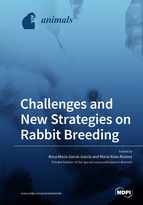Challenges and New Strategies on Rabbit Breeding
A special issue of Animals (ISSN 2076-2615). This special issue belongs to the section "Animal Reproduction".
Deadline for manuscript submissions: closed (30 June 2021) | Viewed by 36004
Special Issue Editors
Interests: embryo; oocyte; follicle; female; ovulation; growth factors; nutrition; hormones; animal reproduction; rabbit
Interests: oocyte competence; preimplantation embryo development; ovary; oviduct; reproductive biotechnologies; nutritional strategies; reproductive physiology; rabbit
Special Issue Information
Dear Colleagues,
In the coming decades, the demand for livestock products will increase with the dramatic rise in world population rises in addition to consumers becoming more conscious and demanding high-quality products. Rabbit husbandry, particularly important in the Mediterranean area and in the semi-arid zones of Africa, Asia, or America, represents a valuable alternative source of good animal protein of high quality (low fat and low cholesterol). As rabbits are being chosen, worldwide, as a livestock species due to their reproductive and feeding advantages, modern rabbit breeding will face some important future challenges that must be resolved in the next few years to ensure it remains a competitive and sustainable sector. Different strategies should be used to maintain a balance between rabbit welfare, customer demands, and breeder requirements. An improvement in breeding systems is needed, and may involve avoiding hormones and antibiotics; enhancing the efficiency of reproductive procedures such as artificial insemination systems or freezing of semen and embryos, among others; extending the productive lifespan of does; and adjusting nutritional systems to optimize the physiological status of animals. This Special Issue aimed to publish high-quality manuscripts, including original research studies and reviews, that mainly address any of these topics in increasing rabbit productivity and sustainability.
Dr. Rosa María García-García
Dr. Maria Arias Alvarez
Guest Editors
Manuscript Submission Information
Manuscripts should be submitted online at www.mdpi.com by registering and logging in to this website. Once you are registered, click here to go to the submission form. Manuscripts can be submitted until the deadline. All submissions that pass pre-check are peer-reviewed. Accepted papers will be published continuously in the journal (as soon as accepted) and will be listed together on the special issue website. Research articles, review articles as well as short communications are invited. For planned papers, a title and short abstract (about 100 words) can be sent to the Editorial Office for announcement on this website.
Submitted manuscripts should not have been published previously, nor be under consideration for publication elsewhere (except conference proceedings papers). All manuscripts are thoroughly refereed through a single-blind peer-review process. A guide for authors and other relevant information for submission of manuscripts is available on the Instructions for Authors page. Animals is an international peer-reviewed open access semimonthly journal published by MDPI.
Please visit the Instructions for Authors page before submitting a manuscript. The Article Processing Charge (APC) for publication in this open access journal is 2400 CHF (Swiss Francs). Submitted papers should be well formatted and use good English. Authors may use MDPI's English editing service prior to publication or during author revisions.
Keywords
- rabbit
- reproduction
- nutrition
- welfare
- productivity
- sustainability
- meat
- longevity







